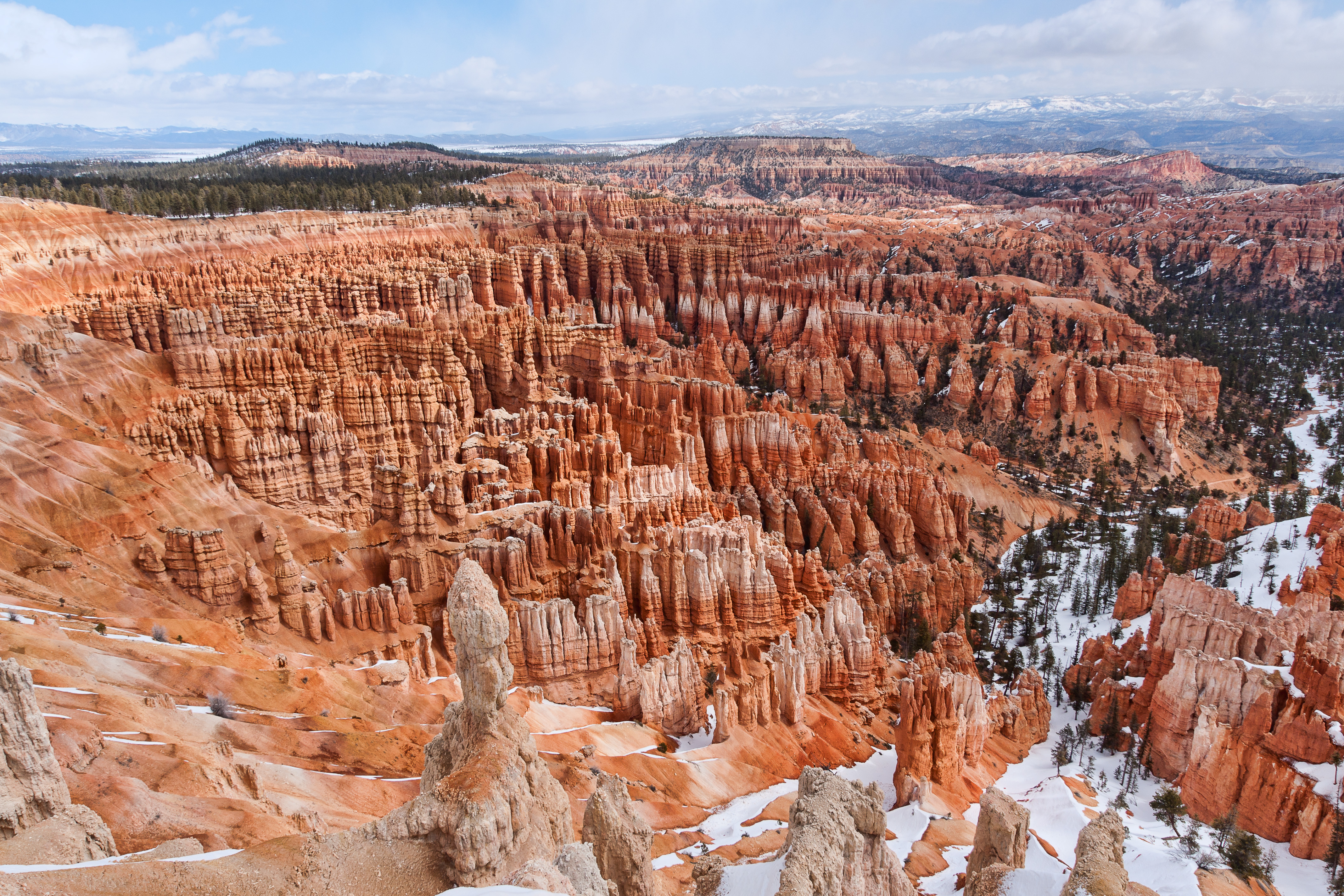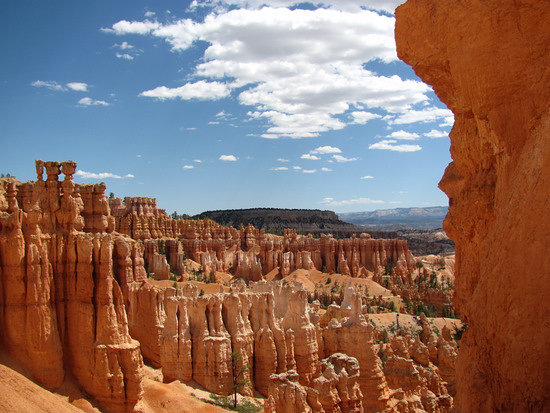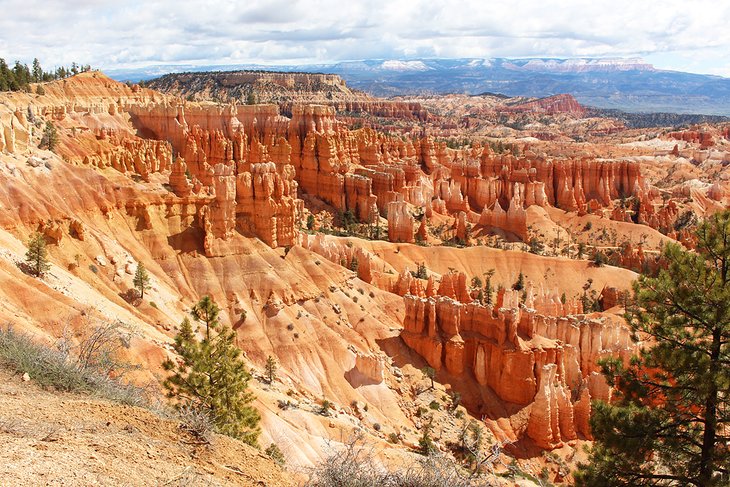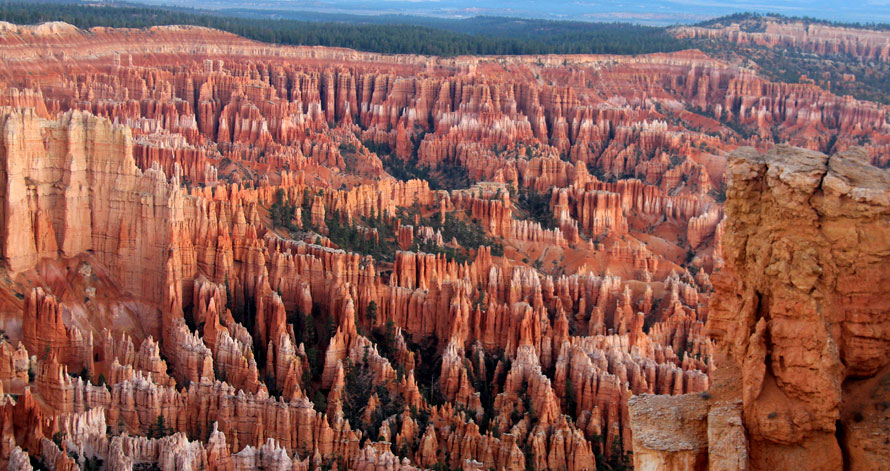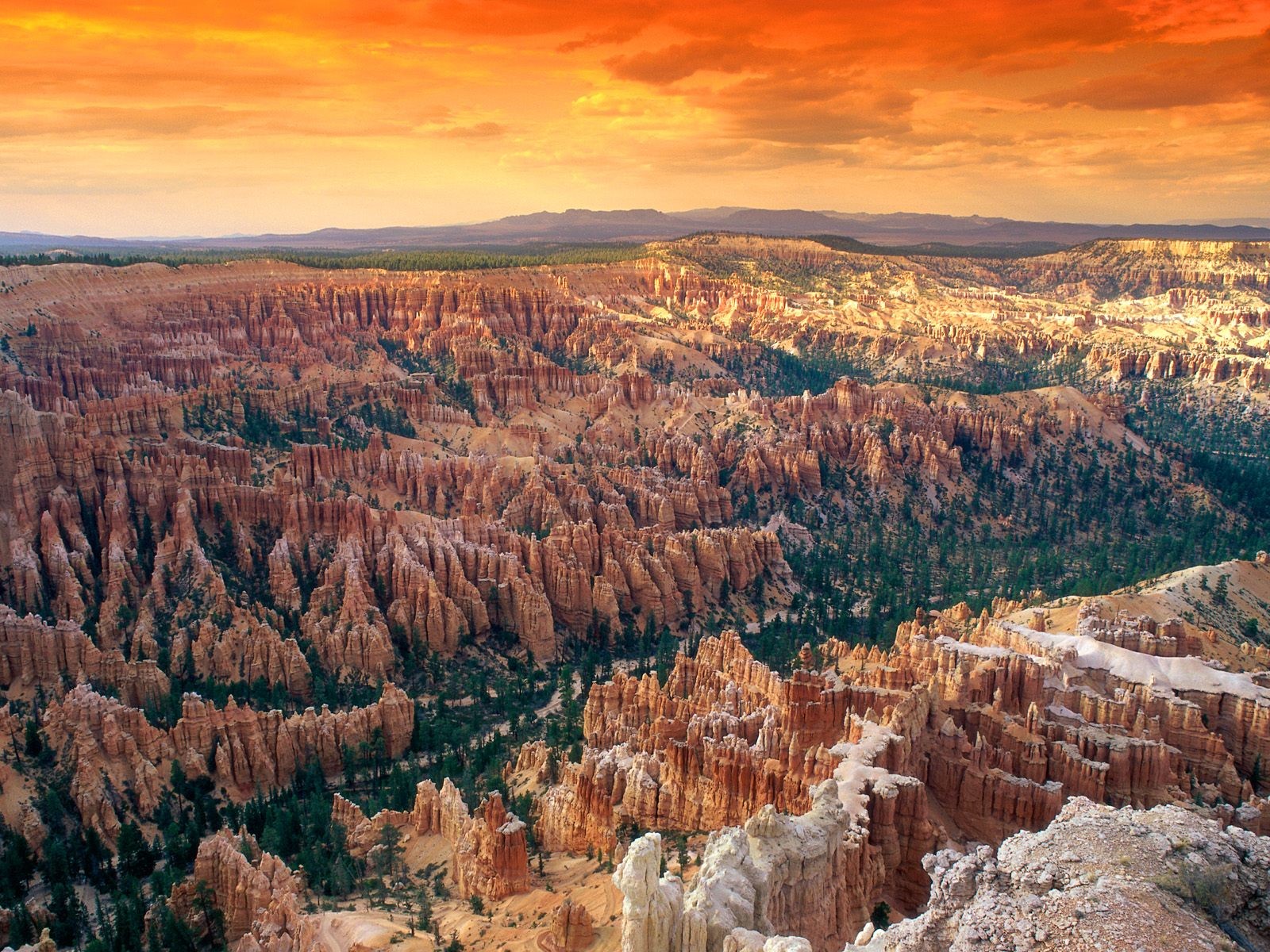Bryce-Canyon-Nationalpark
The Bryce Canyon National Park is located in southwestern Utah in the United States. Reason for designation as a national park is to protect the colored rock pyramids, called hoodoos, to the rim of the Paunsaugunt Plateau. This termination is predominantly non-linear. Instead, to the east open, semi-circular rock basin have eroded into the plateau which are circumscribed by the National Park Service as a "natural amphitheater ". The largest of these is the amphitheater designated incorrectly as Canyon Bryce Canyon.
The Bryce Canyon National Park is located at an altitude 2400-2700 meters and is therefore much higher than nearby Zion National Park and the Grand Canyon National Park.
The park was first settled around 1850 by white settlers and was named after Ebenezer Bryce, who settled there around 1875. The national park was declared a National Monument in 1924 and 1928 to the National Park. Today, well over a million visitors annually visit the park.
Geography
The Bryce Canyon National Park is located in southwestern Utah about 80 km from Zion National Park. With the higher position at 300 meters lower temperatures and more precipitation are connected.
The National Park is located on the Colorado Plateau, more precisely on the southeastern edge of the Paunsaugunt Plateau. The name Paunsaugunt derives from the Uto- Aztec language of Paiute Indians and means home of the beaver. Visitors reach the park from the plateau side and look over the edge into the Pariatal with the eponymous river. The word pariah comes from the Uto- Aztec and means Elchwasser.
Bryce Canyon was not formed by a river. It is thus not a canyon in the strict sense, such as the Grand Canyon. Wind, water and ice eroded the edge of the plateau to large amphitheaters with bizarre rock spiers called hoodoos. These spiers reach up to 60 meters. The resulting amphitheater extend over a length of over 30 km. The largest amphitheater bears the name of Bryce Canyon. It is close to 5 km wide, 19 km long and drops about 240 meters over the plateau from.
History
Early Indian settlements
Little is known about the early human occupation of this park. Archaeological finds date back 10,000 years. A few finds from the southern part of the area are attributed to early Anasazi Indians in the Korbmacherära, some recent finds the Anasazi from the Puebloära.
When the Anasazi Indians left the area for reasons still unknown, came the Paiute Indians, however, hardly any traces of a settlement can be seen. The Paiute used this area rather than hunting ground. However, residues of crops and agricultural use have been found. The Paiute call the hoodoos Anka -ku - wass -a- wits, red -painted faces.
Exploration and settlement by whites
The exploration of the area began in the 19th century. In 1850 came the first Mormons to examine the area for suitability for agriculture and animal husbandry.
The first scientific expedition reached the area in 1872 under the leadership of the U.S. Major John Wesley Powell. The cartographer of the expedition took many names of the Paiute.
Just one year after came a small group of Mormons and moved itself to raise cattle along the Paria River.
1875 was sent here to work on the development of the area as a carpenter Ebenezer Bryce of The Church of Jesus Christ of Latter -day Saints. He built a road up to the plateau, chopping down trees and from it to win boards and firewood. He saw the natural wonders of the more practical side, calling it " a light of a place to lose a cow" as. His neighbors called the canyon near his hut Bryce's Canyon. Along with other settlers built Ebenezer Bryce a channel to be Lord of the constant floods, followed by droughts. But the project failed, and so he moved on to Arizona in 1880.
The emergence of the park
The reports Powell and other newspaper reports promoted the interest in the field, but held due to lack of infrastructure, tourism is limited.
Around 1920, the first overnight accommodations have been created and the Union Pacific Railroad opened up the area so that more and more tourists came to the Bryce Canyon. The unbridled tourism but added the hoodoos and other geological formations quickly damage. The former governor of Utah supported the efforts to protect the canyon and then the Canyon by the President Warren G. Harding in 1923 was declared a National Monument.
In 1924, Congress sought from Utah, to establish Utah National Park, which succeeded in 1928. The name, however, remained at Bryce Canyon National Park.
1931 President Herbert Hoover annexed additional land south of the park and thus enlarged the area to more than 14,000 hectares. 1934, the construction of Scenic Drives began, which still operates today through the park. The management of the park remained until 1956 at the Zion National Park Authority. Since then, the park has its own administration.
Owing to the increased tourism, a shuttle system was established in 2000. There are efforts to make large parts of the park accessible only via this shuttle system, as is already the case in Zion National Park.
Geology
The rock in Bryce Canyon National Park is about 100 million years younger than in Zion National Park and this shows rocks which are again 100 million years younger than the Grand Canyon. Nevertheless, includes all three areas to The Grand Staircase -called formation. From the Grand Canyon to Bryce Canyon can study nearly 200 million years of geological.
The rocks in the National Park are a sequence of basalt and sandstone, in which many fossils can be found. These exposed layers are the youngest in this formation. Even today can be read sandy beaches, lagoons and marshlands.
As the area raised in the course of mountain building, emerged numerous lakes whose sediments covered the basalt and sandstone. This Lakeland had about 20 million years stock and ended about 60 million years ago. During this time, the lakes modified, among other things due to climatic changes. Due to large variation in the size and depth they strongly left -changing sediment layers.
Before about 16 million years ago, picked up the plateau to almost 1000 meters. Prior to that time, the area was almost at sea level. The entire plateau is called Colorado Plateau. It broke up into several smaller plateaus. One of these is the Paunsaugunt plateau.
When the American continent drifted further to the north, the climate change on the plateau, it was significantly cooler and precipitation increased. Frequent rainfall and erosion by freezing water shaped the modern face of the numerous amphitheater, which form a east facing escarpment. Every year, there are still up to 200 frost and thaw periods which still erode the park.
Flora and Fauna
The forests and meadows of the park are home to many birds and mammals. It includes around 60 species of mammals and domestic here over 175 different bird species, of which, however, many are not year-round home in the Bryce Canyon National Park.
Among the predators are foxes and other small animals to occasionally immigrant bobcats (Lynx rufus), mountain lion ( Puma, Puma concolor) and black bear (Ursus americanus). The largest permanently in the park living mammal is the mule deer (Odocoileus hermionus ). Elk (Cervus elaphus ) and pronghorn ( Antilocapra americana ), which were reintroduced into neighboring areas, come as a " visitor " is also occasionally. A very common sight are the Golden-mantled ground squirrel ( Spermophilus lateralis) and the rock squirrel ( Spermophilus variegatus ) and the Uinta chipmunk ( Eutamius umbrinus ) and the Utah prairie dog (Cynomys parvidens ). The mule deer, cougars and coyotes migrate in winter in deeper regions while the squirrels and keep the marmots hibernate.
Most species of Bryce Canyon National Park migrate in the winter to the south ( migratory birds ), about the violets Swallow ( Tachycineta thalassina ) and swifts. However, some remain here all year, including the jays (especially the Clark's Nutcracker ( Clark 's Nutcracker, Nucifraga columbiana )) and the Steller ( Steller's Jay, Cyanocitta stelleri ) and ravens ( Corvus corax), the osprey (Pandion haliaetus), peregrine falcon (Falco peregrinus ) and the California condor ( Gymnogyps californianus ) and various owls and Kleiber.
The herpetofauna consists of eleven reptile and four amphibian species. Particularly striking are among the snakes, the Great Basin prairie rattlesnake (Crotalus viridis lutosus ) and the striped whip snake ( Masticophis taeniatus ), among the lizards, the short horn horned lizard ( Phrynosoma doug lassi ) and the Common side spot Iguana ( Uta stansburiana ). Among the amphibians, the tiger salamander ( Ambystoma tigrinum ) one of the most interesting species dar.
Due to the different heights and the associated vegetation differences within the park different habitats are recognized:
A very dark and nutritious bottom characterizes the park. Ensure together with the water wealth of the region for optimal living conditions.
Activities
The 29 km long scenic drive leads to a total of 13 viewpoints, including Sunrise Point, Sunset Point, Inspiration Point and Bryce Point course. Further to the south of the park, Natural Bridge are ( geologically no bridge, but a bow ) and Rainbow Point and Yovimpa Point.
The park offers numerous hiking trails of varying length and difficulty, so for example:
- Rim Trail between Sunset and Sunrise Points (slightly less than 2 km )
- Mossy Cave (slightly less than 2 km )
- Upper Inspiration Point (medium, less than 2 km )
- Swamp Canyon Loop (medium 7 km)
- Navajo Loop (medium, 3 km )
- Riggs Spring Loop (difficult, 14 km)
- Queen's Garden Trail
- Peek-a -boo Loop (heavy, combined with Queen's Garden Loop and path of the Navajo Loop as an entry, then about 12 km, 550 meters altitude)
In all the walks is to make sure that you are in the high mountains with already correspondingly thinner air and high temperatures can be reached in summer. Appropriate clothing and adequate amounts of fluid are essential for the hikes. More detailed information can be obtained at the visitor center near the entrance. For multi-day hikes, you should ask one of the rangers there for advice.
The air in Bryce Canyon National Park is so clear and the region due to lack of infrastructure at night so dark that you can see more than 7500 stars in the sky with the naked eye. Are usual in residential, light- polluted areas to 2000 visible stars. Due to the clear air up to 320 km to Arizona and New Mexico are possible even on nice days distant views.
The two campsites inside the park have average level, at the entrance of the park, there are more campsites with more comfort (full hook up ) and other attractions, such as Rodeo or overnight stay in a tipi.

